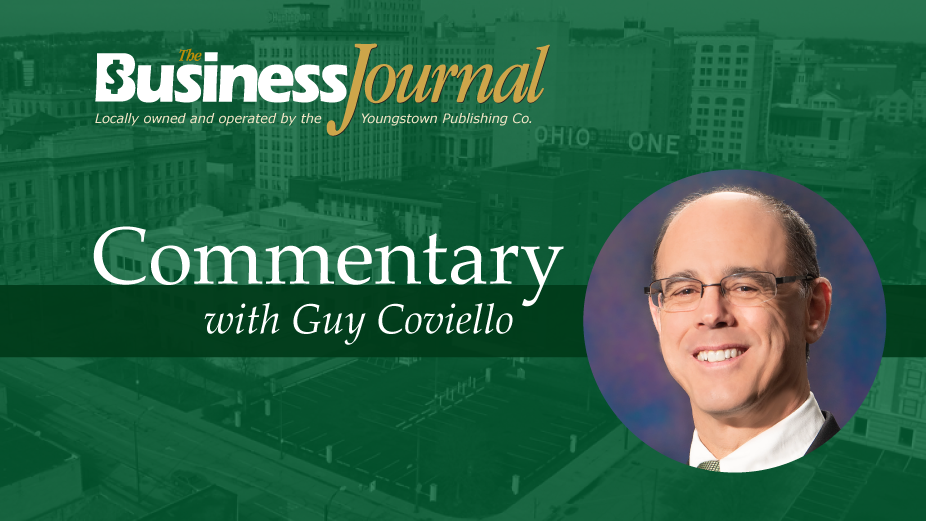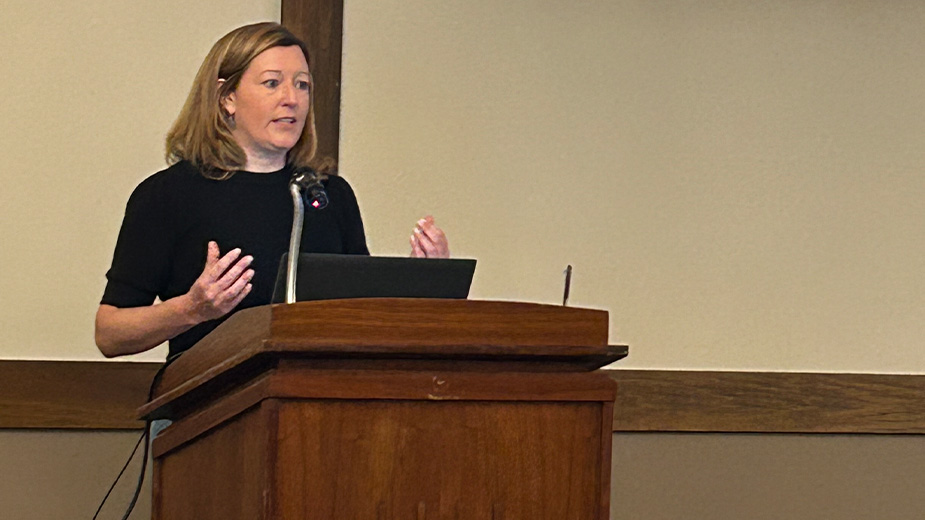America Makes, NFL to Tackle Concussions with Helmet Contest
YOUNGSTOWN, Ohio – The National Football League will team up with America Makes to kick off an initiative to improve helmet technology.
The NFL and America Makes, the federal manufacturing hub dedicated to additive manufacturing, will host a three-day symposium here Nov. 13 through 15 to launch the NFL Helmet Challenge, said Erin O’Donnell, director of partnership and community relations at America Makes.
O’Donnell announced the partnership during the 2019 Impact Ohio Youngstown/Warren Regional Conference Thursday afternoon at Stambaugh Auditorium.
The challenge is intended to stimulate the development and manufacture of a new helmet that outperforms current models, according to an NFL news release. Up to $3 million will be available through the challenge, including $2 million in grant funding to support development of a helmet prototype and a $1 million award.
The three-day conference in November will bring together 300 experts to explore what can be done to increase helmet safety and reduce the risk of concussion through advanced technologies, O’Donnell said.
“Not only do you have the NFL but you have the youth who are playing football, and there’s a lot of concerns around whether they’re taking all the right precautions,” she said. “It really behooves the NFL to try and tackle this from another route, another angle.”
The selection of Youngstown to launch the project is “a great affirmation of the region’s presence in additive manufacturing” and “the collective expertise that we have,” said Barb Ewing, CEO of the Youngstown Business Incubator.
“America Makes is truly the nation’s epicenter and accelerator for additive manufacturing,” she continued. The announcement also serves as confirmation of the hard work that Youngstown State University, America Makes and YBI have put into creating the Northeast Ohio Additive Manufacturing Cluster.
Local business and policy leaders toured the area with NFL representatives and scientists, O’Donnell said. The additive manufacturing ecosystem in place locally was “one of the driving factors” that led NFL officials to decide to launch the helmet challenge here.
“They determined that if they were going to host an event, it would make a lot of sense to have it here in the ecosystem, where you have YSU with leading professors, YBI with some cutting-edge businesses and then America Makes,” she said.
Ewing in particular cited the role played by John and Denise DeBartolo York, the owners of the San Francisco 49ers, in convincing the NFL to bring the conference here. The easy answer for the organization would have been to go to a large major city.
“They really opened the doors to the NFL and helped to make sure that all of the parts were connected, and served as advocates, making sure that everybody understood the capabilities and why this was really the right place to do it,” Ewing said. “They really led the way in helping the NFL understand that this was a better option.”
U.S. Rep. Tim Ryan, D-13 Ohio, said in a news release there is “no better place” to host the helmet challenge symposium than Youngstown, which is “at the forefront of innovation and technology” and “the world leader” in 3D printing and advanced manufacturing technologies.
As a former quarterback and the father of a high-school football player, Ryan said the issue hit home for him.
“Concussions are a widespread and persistent issue not just for athletes competing in the NFL, but in our nation’s colleges, high schools, middle schools, and youth leagues. This is a problem that cannot wait to be fixed,” he said.
O’Donnell participated in one of three panels held during Thursday’s Impact Ohio conference.
Impact Ohio was founded in 1984 with a policy conference that took place after the general election, said Jennifer Flatter, CEO. Eventually, Impact Ohio decided to go beyond the conference it held every two years following the midterm and presidential elections and began conducting regional conferences across the state.
O’Donnell announced the NFL event during a panel discussion that focused on increasing manufacturing competitiveness. Moderated by Jeff Leo Herrmann, CEO of The Business Journal, the panel included Mike Garvey, president and CEO of M-7 Technologies, Youngstown; Mike Hripko, YSU associate vice president, external affairs, government relations and economic development; and state Sen. Matt Dolan, chairman of the senate finance committee.
Asked what inning Youngstown is in when it comes to additive manufacturing, Garvey, taking “a long-term view,” said the area is still in spring training.
“The reason I say that is in 10 years time, things are going to change so dramatically based on digital manufacturing that we won’t even recognize where we are today,” he remarked. Even so, this community “can match up with any community in the United States right now,” and with a little work, any community worldwide, he said.
The two other panels focused on the importance of Youngstown Air Reserve Station and Camp Garfield and the effort to restore the Mahoning River.
YARS, home of the 910th Airlift Wing in Vienna Township, is now the largest employer in Trumbull County, with 2,000 employees total and up to 300 on a daily basis, reported Vito Abruzzino, executive director of the Eastern Ohio Military Affairs Council.
Abruzzino was joined on the military assets panel, moderated by Brenda Linert, editor of the Tribune Chronicle and its new Vindicator edition, by Michael Dustman, director of constituent services for U.S. Sen. Rob Portman, R-Ohio; Joseph Zeis Jr. a retired Air Force colonel and senior policy adviser for aerospace and defense for Gov. Mike DeWine; and state Rep. Rick Perales, R-73 Beavercreek.
Camp Garfield, the former Camp Ravenna, will soon be the premier training installation in this region of the United States, Abruzzino said. “It’s getting to the point that the only thing you can’t do at Camp Garfield is fire tanks,” he said.
A lot of regions don’t have the ability to focus legislative spending because they don’t have an outlet like a federal installation, he added. “If you pay attention” in Columbus and Washington, D.C., and “make yourself have a strong military value overall … the sky’s the limit with what you can attract,” he said.
Perales and Dustman both emphasized the importance of focusing on military assets ahead of processes like the Base Realignment and Closure that took place in 2005.
While Ohio was a winner in the 2005 BRAC, Perales said he was disappointed. “We could have done much better,” he lamented. “Ohio is behind the power curve where Massachusetts, Tennessee and Texas were way out front.” He applauded DeWine for creating Zeis’ position.
Dustman said he was encouraged that communities were no longer waiting to see if the Department of Defense is going to announce another BRAC.
Panelists also addressed the apparent decision to pass over Camp Garfield for a proposed East Coast missile defense site in favor of a site in New York, should it be needed.
The decision came out of a constraint placed by Congress to make the recommendation, and if Defense determines a missile defense site is needed it will conduct a new review process, Dustman said.
“I would say not to give up the fight,” he remarked.
“It’s not over until the president signs the budget,” Abruzzino said.
The third panel addressed the state of the Mahoning River today and efforts to clean it and capitalize on the asset.
Though the Cuyahoga River was notorious for its condition, the Mahoning River in the 1960s and ’70s was “as challenged as any waterway in the country,” said Kurt Princic, district chief for the Ohio Environmental Protection Agency’s Northeast District Office. Water temperature was sometimes higher than 100 degrees, and mills operating along the river asked for water to be released from the dams because the existing water was too hot to make steel.
Moderated by WKBN-TV reporter Amanda Smith, the river panel also featured Warren Mayor Doug Franklin; Jim Kinnick, executive director of Eastgate Regional Council of Governments; and state Sen. Mike Rulli, R-33 Salem.
Cleaning the Mahoning River was one of the main priorities Rulli said communities expressed to him as he prepared to take office this year. Because of that, he chose river cleanup as his top priority in this year’s budget.
Communities along the river now are in the process of removing low-head dams as part of an ongoing effort to clean and utilize the river. Whereas in 1994, just two of 29 sites tested along the river met water quality standards. In 2013, 11 met the standard and 12 partially met it, Princic said.
“It does clean itself but it is a slow process. You accelerate that cleaning if you get the dams out,” Kinnick said. Eastgate and the mayors also are working with businesses along the river to make sure they are not negatively impacted.
“One of our challenges as mayors is to translate the economic benefit and also the quality of life benefit of having a clean river,” Franklin said.
The impact of cleanup efforts to date has already resulted in canoeists and kayakers using the river, Princic said. “That’s the first step and then it’s going to build from there. You’re going to see restaurants. Pretty soon you are going to see people wanting to build condos on the river,” he said.
The afternoon program also featured remarks by state Secretary of State Frank LaRose; state Treasurer Robert Sprague; Ohio Senate President Larry Obhof, R-22 Medina; James Dignan, president and CEO of the Youngstown/Warren Regional Chamber; and Youngstown Mayor Jamael Tito Brown.
Pictured: Jeff Herrmann, CEO of The Business Journal, moderated the panel focused on increasing manufacturing competitiveness with Michael Hripko, associate vice president, external affairs, government relations and economic development, YSU; Erin O’Donnell, director of partnership and community relations, America Makes; state Sen. Matt Dolan, R-24 and Mike Garvey, president and CEO, M-7 Technologies.
Copyright 2024 The Business Journal, Youngstown, Ohio.


